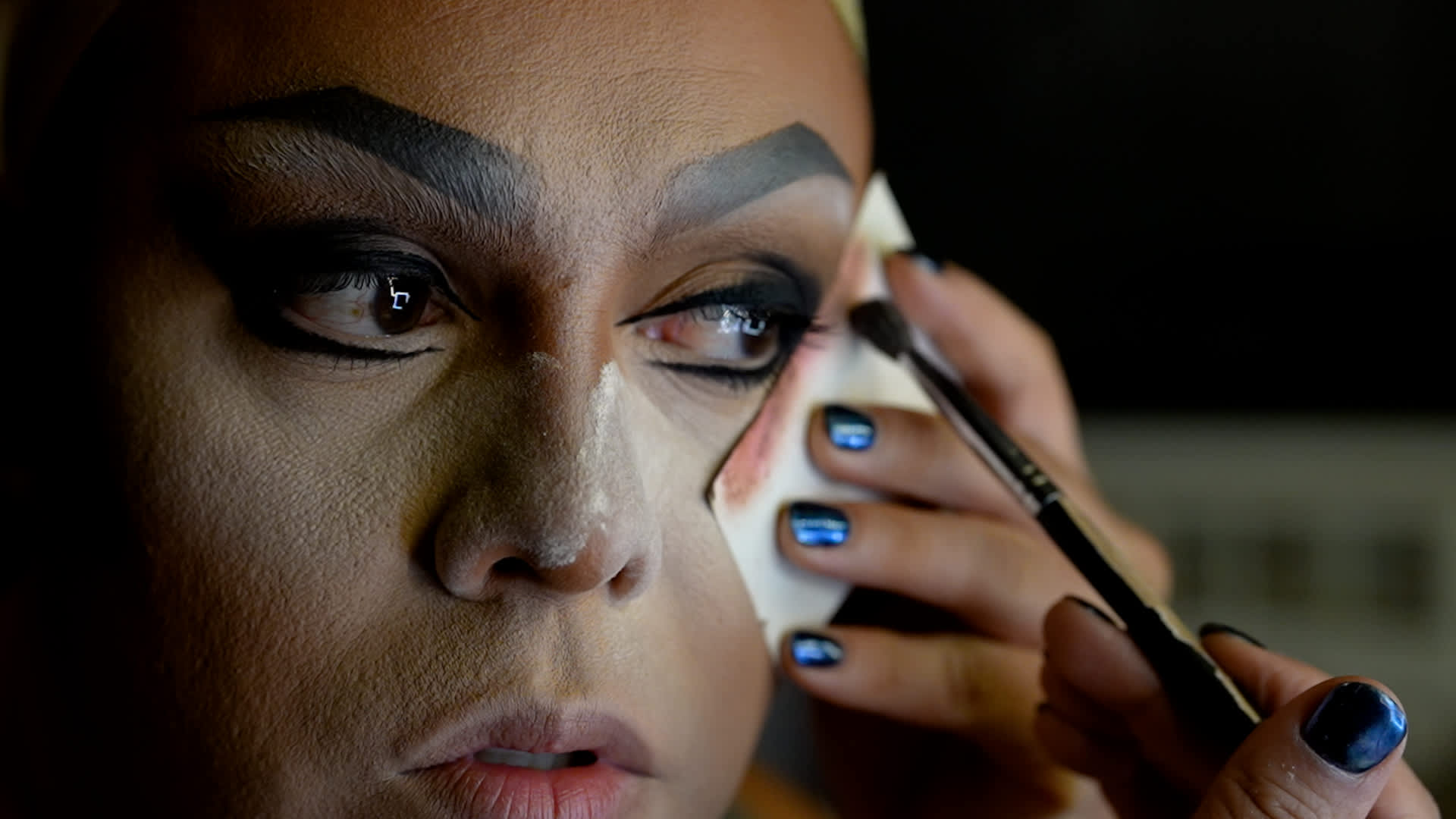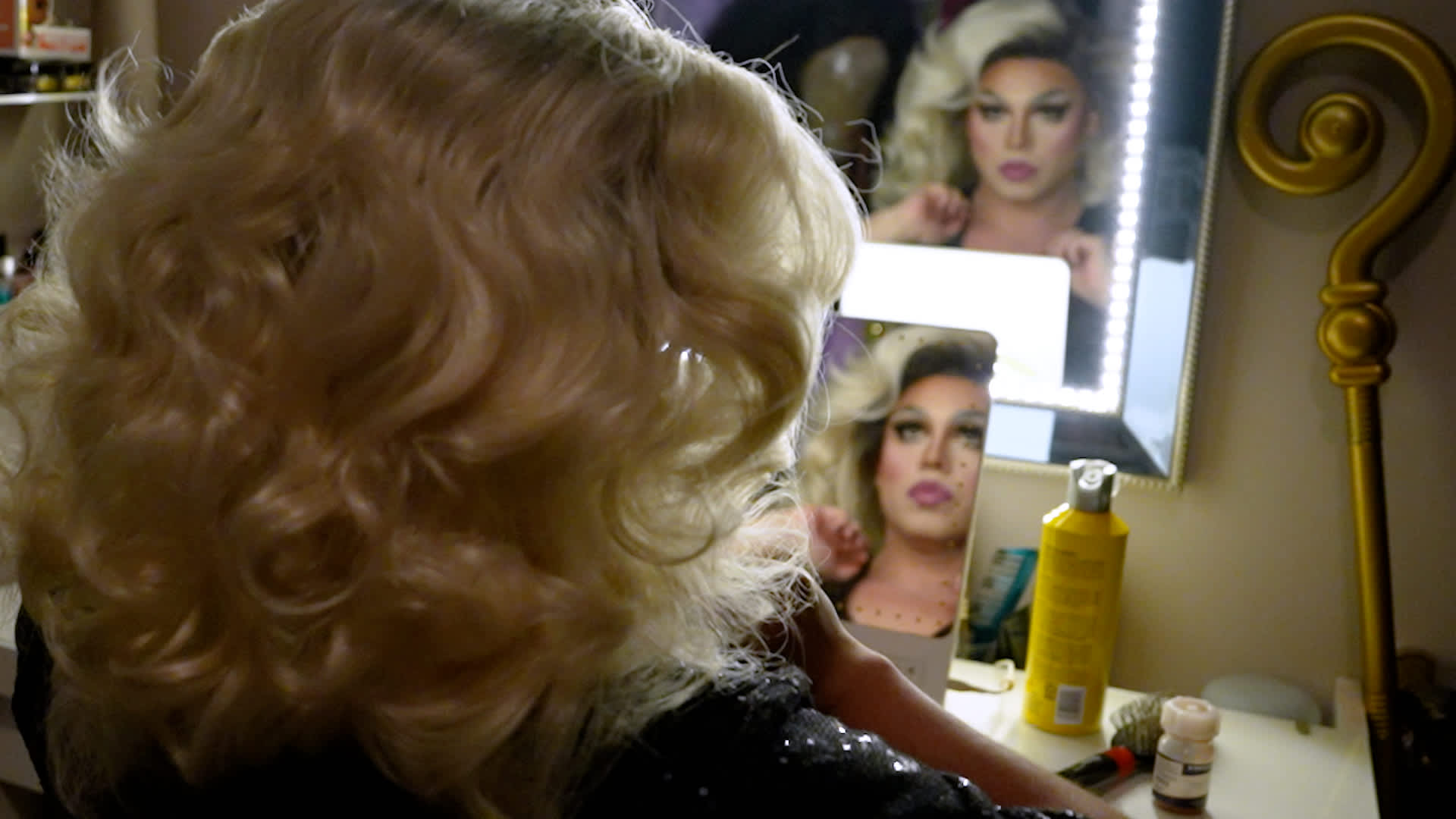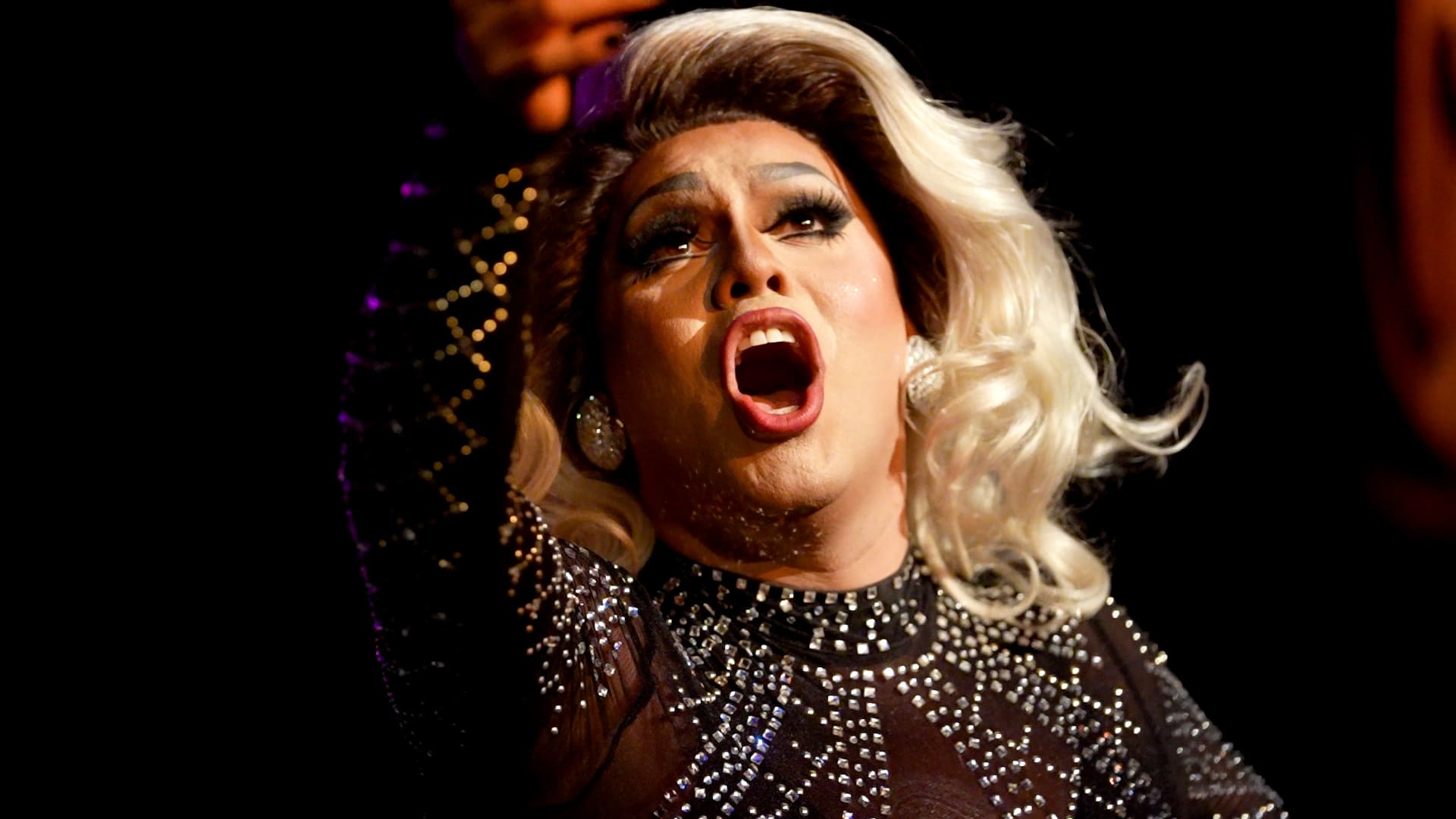
This story is part of CNBC Make It's Millennial Money series, which details how people around the world earn, spend and save their money.
Walk into Cesar Villavicencio's three-bedroom apartment in Washington Heights, New York City, and you might think he had two roommates. In a way, he does.
While Villavicencio occupies one room and another belongs to a friend with whom he splits the rent, the third is reserved for Pixie Aventura, a drag queen whose high-energy dance numbers and one-of-a-kind lip synchs are the stuff of New York gay nightlife legend.
Villavicencio, who moved into the apartment in 2021, says finally putting a door between him and his glamorous alter ego has been "a complete blessing."
We've got the news you need to know to start your day. Sign up for the First & 4Most morning newsletter — delivered to your inbox daily. Sign up here.
"I can lock up my drag. I can lock her up when I'm done and just, like, have a moment to myself," he says.
For the 36-year-old Miami native who moved to New York in 2009, quiet moments are few and far between. Last year alone, in addition to his five weekly shows and summer residency in Fire Island, Villavicencio performed at corporate functions, shared stages with John Leguizamo and Madonna, and appeared on the Hulu series "Drag Me to Dinner."
In 2022, Villavicencio earned about $70,000 performing as a full-time drag queen.
Money Report
In perhaps America's most competitive city for drag, that's quite an achievement, albeit one that Villavicencio chalks up, at least in part, to timing.
"I started doing drag before Drag Race," he says, referring to the TV show that has pulled drag into the mainstream and made overnight celebrities of some of its contestants.
"In a way, I was lucky that I started early on, because I really laid the foundation to create a really good career for myself."
Still, even if starting drag before the reality TV era allowed Villavicencio to get a stiletto in the door, his considerable drive and talent have kept him working and innovating as a performer in a city where would-be stars arrive on the bus every day. Here's how he does it.
From an extracurricular to a career opportunity
At age 15, Villavicencio snuck into a South Florida nightclub with a fake ID. What he was hoping would be another night of dancing with his friends turned into something else when the party was halted for a performance by Vegas Dion. It was the first time Villavicencio had ever seen a drag queen.
"It was something brand new. I couldn't even imagine that it could be a thing. YouTube wasn't so big then. It was really magical," he says.
For the time being though, Villavicencio was finding magic in a different art form: musical theater. "I always separated [drag] from my goals of being a performer. I discovered theater in high school and never really associated drag with my path. I wanted to do theater and dance and sing."
In 2005, Villavicencio enrolled at Otterbein University in Westerville, Ohio, to pursue a degree in musical theater with a concentration in dance. As a freshman, he became one of the founding members of the university's drag show, and by senior year was doing background dancing for queens in nearby Columbus.
Still, he considered drag more of an extracurricular than a career path. It certainly wasn't factoring majorly into his budget. "We were buying our dresses from the Salvation Army. I was using friends' makeup. We got wigs from a Halloween store. Payless was a good friend to us. I think it was all under $100."
Villavicencio graduated in 2009, and, like many aspiring Broadway stars, packed his bags for New York City. Also like many aspiring Broadway stars, he struggled to adjust once he arrived.
"The first year moving to the city was rough," he says. "I say that for anybody who moves here for the first time, even if they have a job coming in: It's still rough. The city knocks you up a bit."
Villavicencio picked up what he calls "survival jobs," such as working retail at West Elm. "It wasn't enough to pay the cheap rent I was splitting with three roommates," he says.
At the same time, working on Broadway was tough sledding. By 2011, "it was just hitting a wall. I would get to the end of all my auditions, but I would be cut right at the end," he says. "I felt like I was trying to fit myself into this hole that was already pre-made with my identities of being Latin and queer. And then drag just came knocking on the door."
Becoming Pixie Aventura
Starting in 2011, Villavicencio was working by day and doing drag by night. Before "Drag Race" became a hit, "it wasn't the most popular career to get into," says Villavicencio.
"It was kind of looked down upon in the theater community. It's kinda like, 'Oh, if you can't be a chorus boy in a musical, then you end up being a drag queen,'" he says.
But in drag, Villavicencio found empowerment that had eluded him. He discovered the joy of having control over his art and of giving his unique voice to queer and Latin identities he often saw portrayed stereotypically growing up.
Originally, Villavicencio found his name by combining the name of his first pet, a black Pomeranian, with a neighborhood in his hometown of Miami. The neighborhood, Aventura, "to me at that point was very bougie. Like, 'Oh, let's go to Aventura.'"
These days, the meaning of the name has evolved. "Pixie is that ethereal fairy creature. It's always growing. It's very mischievous, but it's curious. And then Aventura is adventure in Spanish. So I like to say that I take you on a journey every time I perform."

By 2014, Villavicencio was performing three shows a week while working various day jobs in retail, as a makeup artist at a salon and as a substitute office manager. When he was offered a fourth show, he had a decision to make. "I either had to not sleep, or pursue this as my full-time gig."
As Pixie's reputation grew, so to did Villavicencio's work opportunities. In 2022, he declared 12 different sources of income, including royalties from music he sold online, interest income on his savings and payments for corporate engagements from Cornell Medicine and Visiting Nursing Service of New York.
He earns an average of $150 a night (plus tips) performing his five weekly shows, a rate reserved for more established performers. "The places I've been at longer, it's $200 a show," he says.
His summer performances in Fire Island earn him $500 a show. Corporate gigs, which can include events such as weddings, usually go for $400 a pop. "During Pride Month, it can fluctuate from $600 to $1,500," he says.
Villavicencio says that he's always able to pay his bills with the income he brings in. Sometimes, when things are slower, he runs a small balance on his credit card. But when things pick up in the summers, he pays his card down and increases the amount he stashes away in his savings account.
How he spends his money
Here's how Villavicencio spent his money in May 2023, a typical month.

- Housing: $1,886 on his portion of the rent and utilities he splits with a roommate
- Travel for drag: $1,452 on cabs, ride-hailing services and public transportation to Fire Island
- Food: $1,371 on food delivery, dining out and premade meals from Factor75
- Makeup and costumes: $908
- Discretionary: $242 on movie and concert tickets and other forms of entertainment
- SEP IRA: $150
- Phone: $130
- Subscriptions: $103 on a gym membership and other subscriptions, such as Apple TV and Max
- Subway fare: $69
- Life insurance: $47
Making a living in drag comes with some heavy costs. The biggest line item, though, isn't rhinestones or ostrich feathers. It's wheels. Because Villavicencio dons his makeup for the night at home before heading to shows, taking a ride-hailing service or a cab to the club — as opposed to public transportation — is a matter of safety.
"In New York City, we think it's a safe place, and it really is. I've never really had a big issue," he says. "But there could be that one moment where there could be that person, and I just have to look out for myself."
It's also a matter of punctuality: "I'd rather know that I'm going to get there in in 20, 30 minutes than relying on [the subway], and it's sometimes running maybe an hour late," he says. "Money is time. And I value my time that I don't have to be getting in drag or traveling."

When it comes to getting in drag, Villavicencio's costs, just like his income, can be variable.
"It's all over the place. I have outfits that I can make myself at pretty reasonable prices, like, buying fabric and stuff. But then I have a have a gown that's $4,700. So it could be from a few hundred to that," he says.
Pixie Aventura's wigs run from $150 to $300. Cosmetics: around $150. Heels can run the gamut, but the ones made specifically for dance need to be replaced more often. Those go for between $150 and $200.
Villavicencio has built up a large enough closet that he can go several months without repeating looks, while slowly adding new costumes to the mix. He's constantly replenishing his personal cosmetics "store" with new makeup, lipstick and false lashes. In May, he spent $908 on makeup, fabric, shoes and accessories.
Crucially for Villavicencio's finances, Pixie Aventura isn't just a drag persona. She's an LLC. Last September, Villavicencio hired a financial firm that specializes in working with independent artists to help optimize his financial and tax planning. After all, for a working queen, wigs, Uber rides, Capezios and even the square footage of the apartment's drag room are all business expenses, and all deductible.
Villavicencio gets health insurance through New York City for which he pays no premium, but he does pay in monthly for a life insurance policy.
Looking ahead to homebuying, retirement and more
Another thing Villavicencio's financial team has been harping on: putting money away for the future. What started as an emergency savings fund has blossomed into a savings account where he's accumulating money for short-term goals. He currently has just short of $31,000 stashed away.
His parents plan to buy a house in the next four to five years. "They were like, 'It's going to you eventually, so you should have your name on the title,'" Villavicencio says.

Villavicencio wants to have enough saved to help with the down payment, the monthly costs and even some possible renovating and decorating. "I hate the tile floors in Florida. I hate them," he says.
Villavicencio doesn't make regular contributions to savings, and instead elects to put in decent-sized chunks when he gets a windfall. "With so many different projects coming up, you've got to create looks, and that costs money. So I just have to think about putting it back into the business that way."
One account he does save in regularly is a SEP IRA, a retirement account to which he contributes $150 per month. So far, the account holds about $1,450.
Generally speaking, you don't take money out of those accounts until you're 59½ or older. Pixie Aventura is a long way from retiring, but Villavicencio has some plans for her between now and then. Ideally, he says, he'll take a step back from the constant nightlife performing to focus on continuing "higher level" work, such as theater, television, film and music.
"I've put in time building a name for myself, but I don't necessarily need drag to be the rest of my life," he says. "I'm still a performer at the root of everything."
What's your budget breakdown? Share your story with us for a chance to be featured in a future installment.
DON'T MISS: Want to be smarter and more successful with your money, work & life? Sign up for our new newsletter!
Get CNBC's free Warren Buffett Guide to Investing, which distills the billionaire's No. 1 best piece of advice for regular investors, do's and don'ts, and three key investing principles into a clear and simple guidebook.






